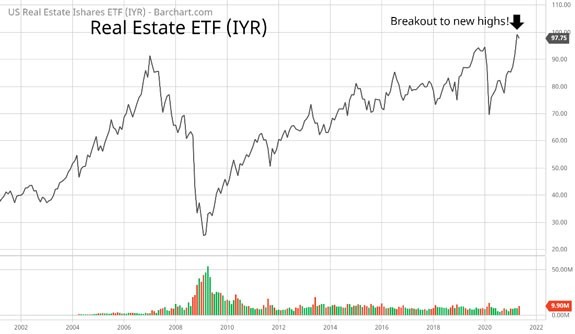Expectations of a hot economy have put cyclical and commodity sectors in the lead this year.
But here’s another top performer you might not have expected: real estate investment trusts (REITs).
That shouldn’t come as a surprise. After all, REITs rank as the best-performing assets class for the past 20 years.
According to data from JPMorgan, REITs have delivered a return of 10% every year for the last two decades, compared to 7.5% for the S&P 500 overall.
REITs also outperform the broader market when the dreaded i-word is doing the rounds … and right now fears of inflation abound.
As a result, real estate companies are breaking out to new all-time highs. Just take a look at the chart of the iShares U.S. Real Estate ETF (NYSE: IYR) below.

(Click here to view larger image.)
But just like any other sector of the stock market, there are REITs to buy and those to avoid.
Here are three metrics to use to uncover the best REITs.
Know Thy REIT
REITs are distinct structures. They’re like partnerships with more favorable tax treatment compared to other publicly traded companies (as Ted explained).
They also must distribute 90% of their income as dividends.
But those unique aspects make traditional fundamental analysis useless for REITs. Instead, analyzing this corner of the market means mastering gauges designed specifically for real estate companies.
There’s more to it than simple things such as yield and dividend history.
To pick the best REIT, look to the following:
Funds From Operations (FFO). FFO is a proxy of cash flow for REITs, and is where your dividends come from. It’s also a crucial valuation measure. Just as common stocks are valued based on their price-to-earnings ratio, REITs are valued based on price to FFO.
Net Operating Income (NOI). NOI is how to gauge the profitability of an REIT. It compares how much income is being produced by a property, like an office building or strip mall. But it also factors in costs such as maintenance fees and property taxes. You can compare NOI results across REITs in the same industry to see who runs the best operation.
Capitalization Rate. NOI is also used to determine the cap rate. This measure looks at NOI relative to a property’s market value. Think of it as an expected rate of return, or a payback period on your investment.
I know, there’s a lot to unpack — and I’ve just barely scratched the surface. But that’s how Ted and I spend our time: evaluating the best possible opportunities to generate and grow your retirement income.
That’s what makes me so excited about our most recent Endless Income pick for The Bauman Letter.
Our newest REIT operates in an industry with the highest cap rate compared to all other property sectors. Its NOI margin is 65% higher than its peers. The dividend yield is 77% higher than the peer group average, and is over five times the income you’d receive from investing in the S&P 500.
And to top it all off, its price to FFO is trading at a 41% discount relative to its peers. To find out more about our newest Endless Income addition, just click here!
Kind regards,
Clint Lee
Research Analyst, The Bauman Letter




